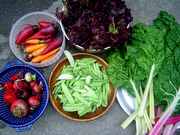

|
| Vegetable Varieties for Gardeners is a citizen science program
|
|
|
|
'Trombetta' Squash - Summer |
| |
| Sub-Category: |
Novelty
|
| |
|
| Sub-Category 2: |
| | Description: |
Italian heirloom. Climbing vines bear 12- to 15-inch, seedless, firm-fleshed, lime-green, trumpet-shaped fruits with artichoke-like flavor. Also known as Climbing Trombetta and Trombetta di Albenga.
|
| Days To Maturity: |
58
|
| Seed Sources: |
|
| |
| Rating Summary |
| |
Overall: (5.0 Stars)
Taste: (4.3 Stars)
Yield: (5.0 Stars)
Ease/Reliability: (5.0 Stars) |
| |
| Reviews |
| |
Login to share your Review of Trombetta.
Number of Reviews: 3
KEY: O=Overall Rating, T=Taste, Y=Yield, E=Ease
Reviewed on 05/30/2012 by
plainolebill
- An experienced gardener
|
 Overall Overall
 Taste Taste
 Yield Yield
 Ease Ease
|
Benton, Oregon, United States
Frost Free Season: 163 - 183 days
Soil Texture: Clay
Garden Size: Small - Less than 400 square feet (20' x 20')
Sun Exposure: More than 8 hours per day
|
| We tried this squash for the first time last year - planted 3 vines to grow up a horse panel. It went up the panel (8 feet) then over the porch. This is one big plant so be prepared. Having said that, we started more for this year, the fruit is big and tasty and since it has no seeds other than in the ball on the end it works well in stews, soups and other dishes where more traditional summer squashes get mushy.
I didn\'t like it as well as zuchinni for grilling it seemed to have a somewhat mealy texture. Perhaps we\'re letting them get too large for that purpose.
Very productive and highly recommended. |
| |
|
Reviewed on 07/11/2009 by
containergardener
- An experienced gardener
|
 Overall Overall
 Taste Taste
 Yield Yield
 Ease Ease
|
Los Angeles, California, United States
Frost Free Season: More than 203 days
Soil Texture: Sand
Garden Size: Medium - 400 square feet to 1,600 square feet
Sun Exposure: More than 8 hours per day
|
| We grow this zucchetta squash under the name "Tromba d'Albegna." It seems to be the same as "trombocino rampicante," listed and reviewed above. In Italy, there are three types of squash: zucchini and close relatives (truly summer squash); zucchetta (can be either summer or winter squash, depending on the amount of time it spends on the vine) and zucca (what we call winter squash). The root word is zucca. Zucchini means "tiny zuccas" while zucchetta significes "rather small zucca." In the British Isles, zucchetta is called marrow or vegetable marrow. The beauty of zucchetta is that you can eat it young as you would zucchini, or you can leave it on the vine, where this variety grows to large size and turns beige. When it is entirely beige (no white stripes), it is ready to be harvested as winter squash. It is very good winter squash, similar to butternut, but tastier. We slice it and bake it with butter, cinnamon and nutmeg. It lasts all winter stored at room temperature. The longer it is stored, the better it gets. It is highly decorative and looks fine on a spinet piano top or as a table decoration. One plant will suffice for a family of ten. Give it plenty of room. It seems resistant to every disease and pest. A few leaves get powdery mildew, but it doesn't seem to phase the vigorous plant. |
| |
|
Reviewed on 03/10/2009 by
jan perry
- An intermediate gardener
|
 Overall Overall
 Taste Taste
 Yield Yield
 Ease Ease
|
Orange, California, United States
Frost Free Season: Fewer than 103 days
Soil Texture: Not Sure
Garden Size: Small - Less than 400 square feet (20' x 20')
Sun Exposure: 6 to 8 hours per day
|
| We have planted Trombetta over the past two summers and it is an easy and delightful alternative to zuccini. Two plants will produce more than you can eat. Give the vine plenty of space to wander and pick them before they get too large as they will lose their flavor. Very limited pest problem. |
| | | 1 of 1 gardener found this review helpful.
|
|
|
|
|
Vegetable Varieties for Gardeners is a citizen science program, © 2004-2024, All Rights Reserved
Cornell Garden Based Learning, Cornell University College of Agriculture & Life Sciences, Horticulture Section
|






 VVfG home
VVfG home

